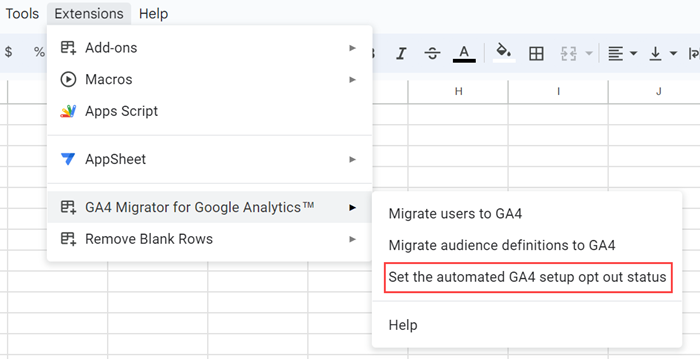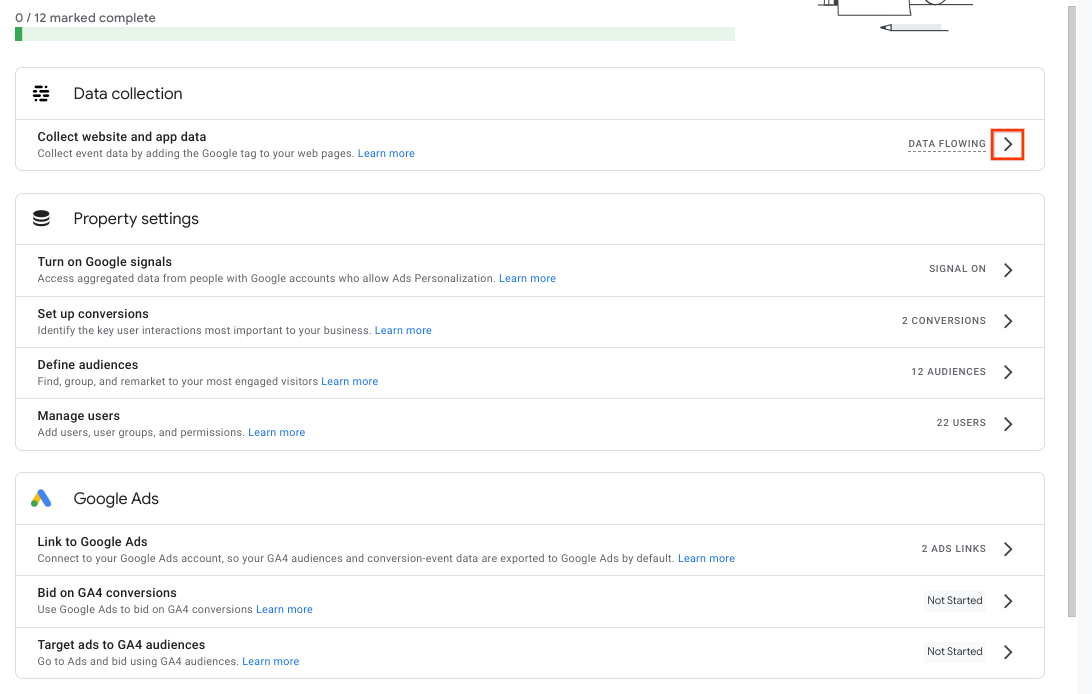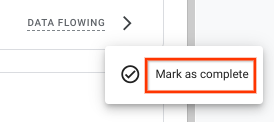A new GA4 property will automatically be created for you, and your Universal Analytics configurations will be copied to the new GA4 property, unless you opt out
Google Analytics 4 has replaced Universal Analytics. Starting July 1, 2023, Universal Analytics properties stopped processing data. If you want to keep using Google Analytics to measure your website traffic, you need a Google Analytics 4 property. To help you with this transition, beginning in March 2023,
- We'll create a GA4 property for you, based on the settings in your Universal Analytics property, unless you opt out.
- If you have already created a GA4 property, and that property is connected to a Universal Analytics property, we'll copy over any configurations (e.g., goals, audiences, etc.) from your Universal Analytics property that you have not marked as complete in your GA4 property, unless you opt out.
Note to Google Analytics 360 customers: This article applies to any standard (i.e., non-360) properties you may have under your 360 account. You must opt out any standard UA properties that you don't want recreated as GA4 properties.
How to opt out
If you opt out, a new GA4 property will not be created for you. If you have already created a GA4 property, no configurations will be copied over from the connected Universal Analytics property, regardless of whether they have been marked as complete or not.
To opt out, you need the Editor role on your Universal Analytics property.
- In Google Analytics, click Admin.
- Make sure you are in the correct account and Universal Analytics property.
- In the Property column, click GA4 Setup Assistant.
- At the bottom of the page, turn off the Automatically set up a basic Google Analytics 4 property toggle. If the toggle is grayed out, the timeline for opting out has passed. Go to the next section, If you didn't opt out in time.
Alternatively, click Manage GA4 migration in the yellow informational banner at the top of your Analytics account. Turn off the Automatically set up a basic Google Analytics 4 property toggle.
If you have multiple properties that you'd like to opt out at the same time, you can use the GA4 Migrator for Google Analytics add-on for Google Sheets. After you've installed it, select Set the automated GA4 setup opt out status, and follow the on-screen directions.

You can also opt out using the Google Analytics Admin API.
If you didn't opt out in time
If you didn't opt out in time and don't want your automatically configured Google Analytics 4 property:
- Click Admin.
- Select your Universal Analytics property.
- In the Property column, click GA4 Setup Assistant.
- Next to "Connected property", click Disconnect.
- Go to your GA4 property and delete it.
If you've already created a Google Analytics 4 property
If you've already created a Google Analytics 4 property, and it's connected to your Universal Analytics property, we'll complete any remaining pieces of the migration for you. This includes migrating remaining goals and Google Ads links, migrating audiences, and updating your connected site tag settings. This also includes key event swapping and audience pairing in linked Google Ads accounts for opted-in properties.
If you want us to copy over some, but not all Universal Analytics configurations to your GA4 property:
- Click Admin.
- Select your GA4 property.
- Click Setup Assistant.
- Mark the configurations that you don't want copied over as complete.
- Click the arrow at the far right.

- Select Mark as complete.

- Repeat this step for each configuration that you don't want copied over from Universal Analytics. (In this case, the progress bar will show "8 of 12 marked complete".)
To ensure that your configurations are copied over from the correct Universal Analytics property:
- In your Universal Analytics property, go to Admin > Property > GA4 Setup Assistant.
- In the I want to connect to an existing Google Analytics 4 property section, select the Google Analytics 4 property that maps to your Universal Analytics property.
- Click Connect properties.
See your new Google Analytics 4 property
After your Google Analytics 4 property has been automatically created, you'll see a blue informational banner at the top of your Analytics account. Click Open Setup Assistant to go to the Admin section of your new Google Analytics 4 property. The Setup Assistant in your Google Analytics 4 property guides you through additional features and settings that you might want to set up. Learn more
In the top-left corner of the Analytics interface is a menu you can use to switch between all of the Analytics accounts and properties for which you have permission. Learn more

How it works
Automatically created Google Analytics 4 properties can help you start your migration from Universal Analytics. Expand each of the following sections to see more details about your automatically created Google Analytics 4 property.
You can also visit change history in your Google Analytics 4 property to see a record of some automatic changes to your property. All automatic migration changes will be labeled System (Migration) in the Changed by column.
Create a GA4 property and web data stream
Your automatically created Google Analytics 4 property will have the same industry category, reporting time zone, and currency as your Universal Analytics property's default view.
It will also have the same property name but with "- GA4" appended to the end of it. For example, if your Universal Analytics property name is "Example property (UA-nnnnnnn)", your GA4 property name will be "Example property - GA4 (xxxxxxx)", without a "UA-" prefix, and where xxxxxxx is a new property number.
Your new GA4 property will also have a new web data stream configured. If you're trying to measure an app, you'll need to create an app data stream and configure your app to send data to GA4.
Copy UA property-level users
Your new Google Analytics 4 property will have the same Universal Analytics property-level users with equivalent permissions. View-level users won't be copied.
Reuse an existing site tag, when possible
If your website is tagged with the Google tag (gtag.js), your automatically created Google Analytics 4 property will use a connected site tag to receive data. Connected site tags do not affect data collection for your Universal Analytics property.
If your website has an analytics.js tag, including through a tag management system like Google Tag Manager, your automatically created Google Analytics 4 property will also receive data via a connected site tag. Many content management systems (CMSs) will have already deployed a Google tag for you; if not, we will create a connected site tag for you.
Not every customer will be eligible for site tag reuse. For example, you'll need to retag your site if you use ga.js or urchin.js. Manually add the Google tag or configure Google Tag Manager for your Google Analytics 4 property to receive data.
Learn about how Google Analytics 4 uses
enhanced measurement to better measure website events, such as site search. Make sure you've enabled all the enhanced measurement features you want to use.
Reproduce UA events using the GA4 data model
There are differences between the Universal Analytics and Google Analytics 4 data models, so your Google Analytics 4 data will look different from your Universal Analytics data.
If you have any custom events set up in your Universal Analytics property, your new GA4 property will automatically collect them as GA4 custom events. The category/action/label values from your UA events automatically get translated to Google Analytics 4 events and parameters as follows:
- Event action becomes an event name in the Google Analytics 4 property.
- Event category, label, and value become event parameters in the Google Analytics 4 property.
This allows your Google Analytics 4 property to collect information that's not collected by default. To display this information in reports, "event_category" and "event_label" event-scoped custom dimensions will also be automatically created.
Reproduce eligible UA goals as conversions based on GA4
Universal Analytics properties can have several different goal types. The following goal types can be automatically migrated:
- Destination: When a user lands on a specific page, such as a "thank you" or "confirmation" page
- Duration: Sessions that lasts a specific amount of time or longer, such as 10 minutes or longer spent on a support site
- Pages/screens per session: When a user views a specific number of pages or screens
- Event: When a user triggers a specific event, such as social recommendation, video play, or ad click
Smart goals aren't eligible for automatic migration.
Your automatically created Google Analytics 4 property will have event creation rules and key events that imitate each eligible Universal Analytics goal. Goals are copied from your Universal Analytics property's default view, and from any other views that have goals used in Google Ads. All automatically created key events use the Once per session counting method to more closely align with how Universal Analytics properties count goals.
If the definition of a Universal Analytics goal uses a regular expression, review the new GA4 key event to make sure that it follows our best practices for using regular expressions.
Reproduce UA audiences in GA4
Many of your Universal Analytics audiences can be automatically migrated. Audiences are copied from your Universal Analytics property's default view, and from any other views that have audiences used in Google Ads.
Audiences based on Pages/Session or Session Duration goals in your Universal Analytics property can't be automatically migrated.
Note: Your
All Users audiences from your Universal Analytics property will be recreated and mapped to the default All Users list in the new Google Analytics 4 property, which has a 540 day membership duration.
Google Analytics 4 audiences can't be edited. Therefore, if you'd like to use an All Users list with a shorter membership duration, you can create a new All Users list with the desired membership duration. Learn more about creating your own audiences
Migrate Google Ads links from UA
All eligible Google Ads links from your Universal Analytics property will be copied to your Google Analytics 4 property, and you'll begin seeing Google Ads data in your Google Analytics 4 reports.
Data from your Google Analytics 4 property will also be available to linked Google Ads accounts.
Swap UA conversions used in Google Ads with GA4 equivalents
If you import conversions from your Universal Analytics property into Google Ads and use them for bidding, these goals will be switched to the GA4 equivalent. This involves the following steps in your Google Ads account:
- import the equivalent GA4 conversion event
- set its action optimization setting to primary
- set the Universal Analytics conversion's action optimization setting to secondary.
If you use a Universal Analytics conversion in a Google Ads custom goal, then the Universal Analytics conversion will be removed and replaced with an equivalent GA4 conversion.
If you use a Smart Campaign, your conversions will be calculated with the Google paid channels last click attribution model in Google Analytics before being imported into Google Ads. This helps capture more conversions.
Pair UA audiences used in Google Ads with GA4 equivalents
If you import audiences from your Universal Analytics property into Google Ads and apply them to advertising campaigns, these audiences will be paired with the GA4 equivalent whenever possible.
Migrate Google AdSense links from UA
All eligible Google AdSense links from your Universal Analytics property will be copied to your Google Analytics 4 property, and you'll begin seeing Google Ads data in your Google Analytics 4 reports.
Next steps
Automatically created Google Analytics 4 properties contain only basic features. Depending on your business and measurement needs, you might want to set up additional features to get the most value out of your new property.
You can also compare key metrics from your Universal Analytics property to those in your new Google Analytics 4 property, and take steps to align configuration and bring the metric counts as close as possible.
If you're an advertiser, you can similarly compare imported Universal Analytics and Google Analytics 4 data in Google Ads.